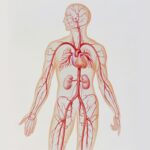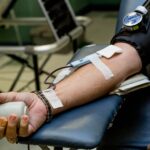 TK2 gene encodes for mitochondrial thymidine kinase, which phosphorylates the pyrimidine nucleosides thymidine and deoxycytidine. Recessive mutations in the TK2 gene are responsible for the ‘myopathic form’ of the mitochondrial depletion/multiple deletions syndrome, with a wide spectrum of severity. We describe 18 patients with mitochondrial myopathy due to mutations in the TK2 gene with absence of clinical symptoms until the age of 12. The mean age of onset was 31 years. The first symptom was muscle limb weakness in 10/18, eyelid ptosis in 6/18, and respiratory insufficiency in 2/18. All patients developed variable muscle weakness during the evolution of the disease. Half of patients presented difficulty in swallowing. All patients showed evidence of respiratory muscle weakness, with need for non-invasive Mechanical Ventilation in 12/18. The late-onset is the less frequent form of presentation of the TK2 deficiency and its natural history is not well known. Patients with late onset TK2 deficiency have a consistent and recognizable clinical phenotype and a poor prognosis, due to the high risk of early and progressive respiratory insufficiency. For more information click here.
TK2 gene encodes for mitochondrial thymidine kinase, which phosphorylates the pyrimidine nucleosides thymidine and deoxycytidine. Recessive mutations in the TK2 gene are responsible for the ‘myopathic form’ of the mitochondrial depletion/multiple deletions syndrome, with a wide spectrum of severity. We describe 18 patients with mitochondrial myopathy due to mutations in the TK2 gene with absence of clinical symptoms until the age of 12. The mean age of onset was 31 years. The first symptom was muscle limb weakness in 10/18, eyelid ptosis in 6/18, and respiratory insufficiency in 2/18. All patients developed variable muscle weakness during the evolution of the disease. Half of patients presented difficulty in swallowing. All patients showed evidence of respiratory muscle weakness, with need for non-invasive Mechanical Ventilation in 12/18. The late-onset is the less frequent form of presentation of the TK2 deficiency and its natural history is not well known. Patients with late onset TK2 deficiency have a consistent and recognizable clinical phenotype and a poor prognosis, due to the high risk of early and progressive respiratory insufficiency. For more information click here.
informer
Gender differences in clinical presentation and vascular pattern in patients with Takayasu arteritis
 To compare clinical characteristics and pattern of vascular involvement at disease onset according to gender specificity in patients with Takayasu arteritis (TA). Data from 117 TA patients (11 male, 106 female), diagnosed according to the American College of Rheumatology criteria, from our centre were retrospectively collected. Differences between men and women regarding demographic features, diagnostic delay, signs and symptoms attributed to TA, and arteries involved at diagnosis were compared. Data were obtained from three published articles describing gender differences in TA. A global analysis of these three cohorts plus ours (a total of 578 patients; 108 men, 470 women) was performed. In our TA cohort, age at disease onset and age at diagnosis were not significantly different between genders. Diagnostic delay was higher in men. Male patients showed higher involvement of iliac arteries, females suffered more frequently from upper limb claudication. In TA patients, gender has a strong influence on pattern of vascular involvement and consequently on clinical presentation. Specifically, women have a higher involvement of the supradiaphragmatic vessels, whereas in men the abdominal vessels are more frequently affected. For more information click here.
To compare clinical characteristics and pattern of vascular involvement at disease onset according to gender specificity in patients with Takayasu arteritis (TA). Data from 117 TA patients (11 male, 106 female), diagnosed according to the American College of Rheumatology criteria, from our centre were retrospectively collected. Differences between men and women regarding demographic features, diagnostic delay, signs and symptoms attributed to TA, and arteries involved at diagnosis were compared. Data were obtained from three published articles describing gender differences in TA. A global analysis of these three cohorts plus ours (a total of 578 patients; 108 men, 470 women) was performed. In our TA cohort, age at disease onset and age at diagnosis were not significantly different between genders. Diagnostic delay was higher in men. Male patients showed higher involvement of iliac arteries, females suffered more frequently from upper limb claudication. In TA patients, gender has a strong influence on pattern of vascular involvement and consequently on clinical presentation. Specifically, women have a higher involvement of the supradiaphragmatic vessels, whereas in men the abdominal vessels are more frequently affected. For more information click here.
 Rett syndrome (RTT) is an early-onset neurodevelopmental disorder that is caused by mutations in the MECP2 gene; however, defects in other genes (CDKL5 and FOXG1) can lead to presentations that resemble classic RTT, although they are not completely identical. Here, we attempted to identify other monogenic disorders that share features of RTT. A total of 437 patients with a clinical diagnosis of RTT-like were studied. A total of 40 patients with clinical features of RTT had variants which affect gene function in six genes associated with other monogenic disorders Genetic studies using next generation sequencing (NGS) allowed us to study a larger number of genes associated with RTT-like simultaneously, providing a genetic diagnosis for a wider group of patients. These new findings provide the clinician with more information and clues that could help in the prevention of future symptoms or in pharmacologic therapy. For more information click here.
Rett syndrome (RTT) is an early-onset neurodevelopmental disorder that is caused by mutations in the MECP2 gene; however, defects in other genes (CDKL5 and FOXG1) can lead to presentations that resemble classic RTT, although they are not completely identical. Here, we attempted to identify other monogenic disorders that share features of RTT. A total of 437 patients with a clinical diagnosis of RTT-like were studied. A total of 40 patients with clinical features of RTT had variants which affect gene function in six genes associated with other monogenic disorders Genetic studies using next generation sequencing (NGS) allowed us to study a larger number of genes associated with RTT-like simultaneously, providing a genetic diagnosis for a wider group of patients. These new findings provide the clinician with more information and clues that could help in the prevention of future symptoms or in pharmacologic therapy. For more information click here.
 Thrombotic thrombocytopenic purpura (TTP) is a rare and life-threatening thrombotic microangiopathy characterized by microangiopathic hemolytic anemia, consumption thrombocytopenia, and organ injury. TTP pathophysiology is based on a severe ADAMTS13 deficiency, the specific von Willebrand factor (VWF)-cleaving protease. Expert opinion: Differential diagnosis of TTP may be challenging and ADAMTS13 investigations are needed. ADAMTS13 conformation could be a promising parameter for TTP diagnosis and prognosis in the coming years. Plasma therapy remains the first-line treatment of the acute phase of TTP. For more information click here.
Thrombotic thrombocytopenic purpura (TTP) is a rare and life-threatening thrombotic microangiopathy characterized by microangiopathic hemolytic anemia, consumption thrombocytopenia, and organ injury. TTP pathophysiology is based on a severe ADAMTS13 deficiency, the specific von Willebrand factor (VWF)-cleaving protease. Expert opinion: Differential diagnosis of TTP may be challenging and ADAMTS13 investigations are needed. ADAMTS13 conformation could be a promising parameter for TTP diagnosis and prognosis in the coming years. Plasma therapy remains the first-line treatment of the acute phase of TTP. For more information click here.
 Hypoparathyroidism is a rare endocrine disorder characterized by low or insufficient parathyroid hormone (PTH) concentrations leading to hypocalcemia, hyperphosphatemia, and markedly reduced bone turnover. Despite being a rare disease, hypoparathyroidism has a profound impact on affected patients. There is a female predominance, and anterior neck surgery is the most common etiology. Recent studies have better elucidated the chronic manifestations of the disease, impacting quality of life and multiple organ systems including the renal, cardiovascular, and skeletal systems. There are now data on longer term use of parathyroid hormone (PTH) and PTH analogs. This review focuses on recent contributions to the literature on the prevalence and epidemiology of the disease, risk of chronic manifestations, and treatment with PTH(1-34) and rhPTH(1-84). Further research is needed to determine the pathophysiology of complications in hypoparathyroidism and whether interventions can decrease future risk of these complications. In addition, further data are needed with regards to more physiologic dosing regimens and long-term treatment with PTH and PTH analogs. For more information click here.
Hypoparathyroidism is a rare endocrine disorder characterized by low or insufficient parathyroid hormone (PTH) concentrations leading to hypocalcemia, hyperphosphatemia, and markedly reduced bone turnover. Despite being a rare disease, hypoparathyroidism has a profound impact on affected patients. There is a female predominance, and anterior neck surgery is the most common etiology. Recent studies have better elucidated the chronic manifestations of the disease, impacting quality of life and multiple organ systems including the renal, cardiovascular, and skeletal systems. There are now data on longer term use of parathyroid hormone (PTH) and PTH analogs. This review focuses on recent contributions to the literature on the prevalence and epidemiology of the disease, risk of chronic manifestations, and treatment with PTH(1-34) and rhPTH(1-84). Further research is needed to determine the pathophysiology of complications in hypoparathyroidism and whether interventions can decrease future risk of these complications. In addition, further data are needed with regards to more physiologic dosing regimens and long-term treatment with PTH and PTH analogs. For more information click here.
 Balance impairment contributes to gait dysfunction, falls, and reduced quality of life in adults with Charcot-Marie-Tooth disease (CMT) but has been minimally examined in pediatric CMT. The CMT Pediatric Scale (CMTPedS) was administered to 520 children with CMT. Associations between balance function (Bruininks-Oseretsky Test of Motor Proficiency [BOT-2]) and sensorimotor and gait impairments were investigated. Balance impairment occurs from a young age in children with CMT. Balance intervention studies are required in pediatric CMT and should consider the degree of sensorimotor impairment, foot malalignment, and visual dependence. For more information click here.
Balance impairment contributes to gait dysfunction, falls, and reduced quality of life in adults with Charcot-Marie-Tooth disease (CMT) but has been minimally examined in pediatric CMT. The CMT Pediatric Scale (CMTPedS) was administered to 520 children with CMT. Associations between balance function (Bruininks-Oseretsky Test of Motor Proficiency [BOT-2]) and sensorimotor and gait impairments were investigated. Balance impairment occurs from a young age in children with CMT. Balance intervention studies are required in pediatric CMT and should consider the degree of sensorimotor impairment, foot malalignment, and visual dependence. For more information click here.
 Rare disease patients find independent health information seeking necessary due to the general lack of knowledge on rare diseases and inadequate information provision by health care professionals. The aim of this study is to describe distinctive aspects of health information behaviour of rare disease patients and specific challenges they face when seeking health information. A qualitative research approach was employed including semi-structured interviews that were analysed using thematic analysis. Fifteen respondents suffering from three different rare diseases participated in the study. Health information behaviour of rare disease patients is characterised by independent and continuous health information seeking and sharing. Connecting with other patients and getting realistic insight into the condition after diagnosis, advice for everyday life, comfort and hope and confirmation that their symptoms are ‘normal’ are of particular importance. Lack of specific advice for daily life, inaccessible new knowledge, lack of information about drugs and encountering severe health information are common challenges patients face due to insufficient support from health care professionals. Health information seeking and sharing are important aspects of rare disease patients’ everyday life. Challenges they face could be overcome in cooperation with patient support groups, health care professionals and health information professionals. For more information click here.
Rare disease patients find independent health information seeking necessary due to the general lack of knowledge on rare diseases and inadequate information provision by health care professionals. The aim of this study is to describe distinctive aspects of health information behaviour of rare disease patients and specific challenges they face when seeking health information. A qualitative research approach was employed including semi-structured interviews that were analysed using thematic analysis. Fifteen respondents suffering from three different rare diseases participated in the study. Health information behaviour of rare disease patients is characterised by independent and continuous health information seeking and sharing. Connecting with other patients and getting realistic insight into the condition after diagnosis, advice for everyday life, comfort and hope and confirmation that their symptoms are ‘normal’ are of particular importance. Lack of specific advice for daily life, inaccessible new knowledge, lack of information about drugs and encountering severe health information are common challenges patients face due to insufficient support from health care professionals. Health information seeking and sharing are important aspects of rare disease patients’ everyday life. Challenges they face could be overcome in cooperation with patient support groups, health care professionals and health information professionals. For more information click here.
Тhe Value of Innovative Pharmaceutical Therapies in Oncology and Hematology
 The team of the Institute for Rare Diseases has published a new scientific study. The aim of the study is to analyze the views of Bulgarian oncologists and hematologists regarding the value of innovative pharmaceutical treatments in their clinical area. Physicians were invited to review a life-prolonging scenario and to indicate what minimum improvement in median survival a new treatment would have to generate for them to recommend it over the standard of care. Respondents were also asked to state the highest cost at which they would recommend a new therapy that would improve patient’s health-related quality of life (HRQoL) but would have no impact on survival. In addition, physicians were asked whether they would consider different responses under certain circumstances. Responses were used to calculate incremental cost-effectiveness ratios (ICERs) for each scenario. They found a high willingness-to-pay for innovative drugs in oncology and hematology. The wide range of responses observed, however, indirectly implies a lack of consensus on the use of explicit ICER thresholds in Bulgaria. For more information click here.
The team of the Institute for Rare Diseases has published a new scientific study. The aim of the study is to analyze the views of Bulgarian oncologists and hematologists regarding the value of innovative pharmaceutical treatments in their clinical area. Physicians were invited to review a life-prolonging scenario and to indicate what minimum improvement in median survival a new treatment would have to generate for them to recommend it over the standard of care. Respondents were also asked to state the highest cost at which they would recommend a new therapy that would improve patient’s health-related quality of life (HRQoL) but would have no impact on survival. In addition, physicians were asked whether they would consider different responses under certain circumstances. Responses were used to calculate incremental cost-effectiveness ratios (ICERs) for each scenario. They found a high willingness-to-pay for innovative drugs in oncology and hematology. The wide range of responses observed, however, indirectly implies a lack of consensus on the use of explicit ICER thresholds in Bulgaria. For more information click here.
Eidikology: proposition for a new terminology for the science of rare diseases
 The European Union defines a disease as rare when it affects fewer than 5 per 10 000 persons, whereas the USA considers a condition rare if it affects fewer than 200 000 individuals. To date, however, there is no terminology to appropriately address these diseases as a category other than rare diseases, or in some instances orphan diseases when referring to conditions that lack the resources for treatment discovery. For more information click here.
The European Union defines a disease as rare when it affects fewer than 5 per 10 000 persons, whereas the USA considers a condition rare if it affects fewer than 200 000 individuals. To date, however, there is no terminology to appropriately address these diseases as a category other than rare diseases, or in some instances orphan diseases when referring to conditions that lack the resources for treatment discovery. For more information click here.
 Marfan’s syndrome (MFS) is a systemic disorder of connective tissue caused by mutations in the
Marfan’s syndrome (MFS) is a systemic disorder of connective tissue caused by mutations in the
extracellular matrix protein fibrillin-1. Orofacial characteristics may be useful in identification of the syndrome. Severe periodontitis is sometimes observed in MFS patients, but no in-depth information has been reported in Italian groups of growing subjects with MFS. The aim of this study was to analyze the periodontal condition on a group of growing subjects affected by MFS, in comparison with a typically developed control group. A group of 16 subjects with diagnosed MFS were recruited from the Centre for Rare Diseases for Marfan Syndrome and Related Disorders of Tor Vergata University Hospital. The Marfan Group (MG) was compared with a Control Group (CG) composed by 20 nonsyndromic subjects. The periodontal clinical parameters like Marginal Gingival Thickness (GT), Plaque Index (PI), Bleeding On Probing (BOP) and Modified Periodontal Screening and Recording (PSR) were assessed. Patients with Marfan syndrome reveal a higher presence of plaque and consequently a generalized inflammation in the oral cavity when compared with a control group. For more information click here.
